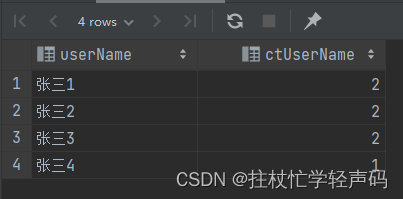mysql常用函数之group_concat()、groupby、count()、casewhenthen的使用
场景:
一、行转列函数 group_concat(arg)
二、分组 group by、count()、sum() 函数的组合使用
三、count() 配合 case when then 的使用
场景:在mysql的关联查询或子查询中,函数 group_concat(arg) 可以合并多行的某列(或多列)数据为一行,默认以逗号分隔。以及分组函数和统计函数的组合使用
测试数据准备:

1、单列合并,默认以逗号分隔
select
group_concat(ttop.user_name) as testStr
from t_table_one_parent ttop;
输出:
张三1,张三2,张三3,张三1,张三2,张三3,张三4
2、单列合并,指定冒号分隔符
select
group_concat(ttop.user_name separator ';') as testStr
from t_table_one_parent ttop;
输出:
张三1;张三2;张三3;张三1;张三2;张三3;张三4
3、单列合并,并去重
select
group_concat(distinct ttop.user_name separator ';') as testStr
from t_table_one_parent ttop;
输出:
张三1;张三2;张三3;张三4
4、多列拼接合并
select
group_concat(distinct ttop.user_name, ttop.company_code separator ';') as testStr
from t_table_one_parent ttop;
输出:
张三1123456;张三21234567;张三312345678;张三4123456789
5、多列拼接合并,列和列之间指定分隔符
select
group_concat(distinct ttop.user_name, ',', ttop.company_code separator ';') as testStr
from t_table_one_parent ttop;
输出:
张三1,123456;张三2,1234567;张三3,12345678;张三4,123456789
小结:
1、group_concat() 函数默认合并后以逗号分隔,也可以自定义分隔符
2、group_concat() 函数可以多列合并,列和列之间可以自定义分隔符
3、group_concat() 函数可以使用 distinct 进行去重合并
1、分组和统计
select
user_name as userName,
count(user_name) as ctUserName
from t_table_one_parent ttop group by user_name;
输出:
2、分组和求和
select
user_name as userName,
count(user_name) as ctUserName,
sum(total_account_balance) as sumTab
from t_table_one_parent ttop group by user_name;
输出:

小结:
1、group by 分组可以配合 count() 统计函数综合使用,输出每组中的数量
2、group by 分组可以配合 sum() 求和函数综合使用,输出每组中的数字的和
3、group by 分组可以配合 count()、sum() 一起使用,输出每组中的数量以及和
脚本备份:
create table if not exists t_department_info
(
id bigint not null primary key auto_increment comment '主键id',
dept_name varchar(50) not null comment '部门名称',
dept_director varchar(20) not null comment '部门主管',
create_by bigint comment '创建人Id',
create_date datetime not null default now() comment '创建时间',
update_by bigint comment '更新人Id',
update_date datetime not null default now() on update now() comment '更新时间'
) engine = InnoDB
auto_increment = 1
default charset = utf8 comment '部门信息表';
create table if not exists t_person_info
(
id bigint not null primary key auto_increment comment '主键id',
person_name varchar(10) not null comment '人员名称',
id_number varchar(50) not null comment '省份证号',
gender varchar(5) not null comment '性别,M男、F女',
induction_date datetime null comment '入职日期',
quit_date datetime null comment '离职日期',
if_on_job tinyint(1) default 1 comment '是否在职状态,0-否,1-是',
dept_id bigint null comment '部门Id',
create_by bigint comment '创建人Id',
create_date datetime not null default now() comment '创建时间',
update_by bigint comment '更新人Id',
update_date datetime not null default now() on update now() comment '更新时间'
) engine = InnoDB
auto_increment = 1
default charset = utf8 comment '人员资料信息表';
-- 写入数据
INSERT INTO any_case.t_department_info (id, dept_name, dept_director, create_by, create_date, update_by, update_date) VALUES (1, '研发部', '张三', 1, '2022-12-22 16:38:10', null, '2022-12-22 16:38:10');
INSERT INTO any_case.t_department_info (id, dept_name, dept_director, create_by, create_date, update_by, update_date) VALUES (2, '测试部', '张三', 1, '2022-12-22 16:38:10', null, '2022-12-22 16:38:10');
INSERT INTO any_case.t_department_info (id, dept_name, dept_director, create_by, create_date, update_by, update_date) VALUES (3, '运维部', '李四', 1, '2022-12-22 16:38:10', null, '2022-12-22 16:38:10');
INSERT INTO any_case.t_person_info (id, person_name, id_number, gender, induction_date, quit_date, if_on_job, dept_id, create_by, create_date, update_by, update_date) VALUES (1, '张三', '123456789987654321', 'M', '2022-11-23 00:40:35', null, 1, 1, 1, '2022-12-22 16:40:48', null, '2022-12-22 16:40:48');
INSERT INTO any_case.t_person_info (id, person_name, id_number, gender, induction_date, quit_date, if_on_job, dept_id, create_by, create_date, update_by, update_date) VALUES (2, '李四', '123456789987654321', 'F', '2022-11-23 00:40:35', '2022-12-23 00:54:47', 0, 1, 1, '2022-12-22 16:40:48', null, '2022-12-22 16:54:40');
INSERT INTO any_case.t_person_info (id, person_name, id_number, gender, induction_date, quit_date, if_on_job, dept_id, create_by, create_date, update_by, update_date) VALUES (3, '王五', '123456789987654321', 'M', '2022-11-23 00:40:35', '2022-11-30 00:54:54', 0, 1, 1, '2022-12-22 16:40:48', null, '2022-12-23 02:13:29');
INSERT INTO any_case.t_person_info (id, person_name, id_number, gender, induction_date, quit_date, if_on_job, dept_id, create_by, create_date, update_by, update_date) VALUES (4, '赵六', '123456789987654321', 'F', '2022-11-23 00:40:35', null, 1, 2, 1, '2022-12-22 16:40:48', null, '2022-12-22 16:40:48');
INSERT INTO any_case.t_person_info (id, person_name, id_number, gender, induction_date, quit_date, if_on_job, dept_id, create_by, create_date, update_by, update_date) VALUES (5, '李七', '123456789987654321', 'M', '2022-11-23 00:40:35', null, 1, 2, 1, '2022-12-22 16:40:48', null, '2022-12-22 16:40:48');
INSERT INTO any_case.t_person_info (id, person_name, id_number, gender, induction_date, quit_date, if_on_job, dept_id, create_by, create_date, update_by, update_date) VALUES (6, '郑八', '123456789987654321', 'F', '2022-11-23 00:40:35', null, 1, 1, 1, '2022-12-22 16:41:17', null, '2022-12-22 17:00:22');
1、主从表关联查询统计示例脚本
select tdi.dept_name,
tdi.dept_director
,count(tpi.id) as allPersonNum-- 全部人数
,count(case when tpi.if_on_job = 1 then tpi.id end) as ifOnJobNum -- 在职全部人数
,count(case when tpi.if_on_job = 1 and tpi.gender = 'M' then tpi.id end) as ifOnJobMNum -- 在职男性人数
,count(case when tpi.if_on_job = 1 and tpi.gender = 'F' then tpi.id end) as ifOnJobFNum -- 在职女性人数
,count(case when tpi.if_on_job = 0 then tpi.id end) as quitNum -- 离职总人数
,count(case when tpi.if_on_job = 0 and date_format(tpi.quit_date, '%Y-%m') = date_format(now(), '%Y-%m') then tpi.id end) as quitNumThisMonth -- 本月离职人数
from t_department_info tdi
left join t_person_info tpi on tpi.dept_id = tdi.id
#支持主表和从表过滤
where tdi.dept_director like '%张%'
and (tpi.if_on_job = 0 and date_format(tpi.quit_date, '%Y-%m') = date_format(now(), '%Y-%m')) > 0
and tpi.person_name like '%李%'
group by tdi.dept_name, tdi.dept_director;
可见主与从表关系为一对多,而查询列中的 count() 中根据从表中的条件来判断是否统计入该条数据,符合条件的话返回给 count() 统计依据列,不符合条件返回给 count() 统计依据为 null(默认null不统计)
2、这样写的好处比关联多个 left join 对象这种方式的查询效率要快很多,而且还简洁明了不混乱
到此这篇关于mysql常用函数之group_concat()、group by、count()、case when then的使用的文章就介绍到这了,更多相关mysql group_concat()、group by、count()、case when then内容请搜索软件开发网以前的文章或继续浏览下面的相关文章希望大家以后多多支持软件开发网!